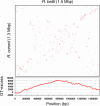Genome sequence of Rickettsia bellii illuminates the role of amoebae in gene exchanges between intracellular pathogens
- PMID: 16703114
- PMCID: PMC1458961
- DOI: 10.1371/journal.pgen.0020076
Genome sequence of Rickettsia bellii illuminates the role of amoebae in gene exchanges between intracellular pathogens
Abstract
The recently sequenced Rickettsia felis genome revealed an unexpected plasmid carrying several genes usually associated with DNA transfer, suggesting that ancestral rickettsiae might have been endowed with a conjugation apparatus. Here we present the genome sequence of Rickettsia bellii, the earliest diverging species of known rickettsiae. The 1,552,076 base pair-long chromosome does not exhibit the colinearity observed between other rickettsia genomes, and encodes a complete set of putative conjugal DNA transfer genes most similar to homologues found in Protochlamydia amoebophila UWE25, an obligate symbiont of amoebae. The genome exhibits many other genes highly similar to homologues in intracellular bacteria of amoebae. We sought and observed sex pili-like cell surface appendages for R. bellii. We also found that R. bellii very efficiently multiplies in the nucleus of eukaryotic cells and survives in the phagocytic amoeba, Acanthamoeba polyphaga. These results suggest that amoeba-like ancestral protozoa could have served as a genetic "melting pot" where the ancestors of rickettsiae and other bacteria promiscuously exchanged genes, eventually leading to their adaptation to the intracellular lifestyle within eukaryotic cells.
Conflict of interest statement
Competing interests. The authors have declared that no competing interests exist.
Figures







Similar articles
-
Lateral gene transfer between obligate intracellular bacteria: evidence from the Rickettsia massiliae genome.Genome Res. 2007 Nov;17(11):1657-64. doi: 10.1101/gr.6742107. Epub 2007 Oct 4. Genome Res. 2007. PMID: 17916642 Free PMC article.
-
The genome of the amoeba symbiont "Candidatus Amoebophilus asiaticus" reveals common mechanisms for host cell interaction among amoeba-associated bacteria.J Bacteriol. 2010 Feb;192(4):1045-57. doi: 10.1128/JB.01379-09. Epub 2009 Dec 18. J Bacteriol. 2010. PMID: 20023027 Free PMC article.
-
Transcriptional Analysis of the Conjugal Transfer Genes of Rickettsia bellii RML 369-C.PLoS One. 2015 Sep 9;10(9):e0137214. doi: 10.1371/journal.pone.0137214. eCollection 2015. PLoS One. 2015. PMID: 26352829 Free PMC article.
-
Plasmids and rickettsial evolution: insight from Rickettsia felis.PLoS One. 2007 Mar 7;2(3):e266. doi: 10.1371/journal.pone.0000266. PLoS One. 2007. PMID: 17342200 Free PMC article. Review.
-
Rickettsial evolution in the light of comparative genomics.Biol Rev Camb Philos Soc. 2011 May;86(2):379-405. doi: 10.1111/j.1469-185X.2010.00151.x. Epub 2010 Aug 17. Biol Rev Camb Philos Soc. 2011. PMID: 20716256 Review.
Cited by
-
Molecular detection of Rickettsia aeschlimannii, Candidatus Rickettsia shennongii, Rickettsia sp. and Coxiella burnetii in ticks collected from camels.Sci Rep. 2024 Sep 27;14(1):22129. doi: 10.1038/s41598-024-73663-7. Sci Rep. 2024. PMID: 39333333 Free PMC article.
-
Bacteriophages encode factors required for protection in a symbiotic mutualism.Science. 2009 Aug 21;325(5943):992-4. doi: 10.1126/science.1174463. Science. 2009. PMID: 19696350 Free PMC article.
-
Ancestrality and Mosaicism of Giant Viruses Supporting the Definition of the Fourth TRUC of Microbes.Front Microbiol. 2018 Nov 27;9:2668. doi: 10.3389/fmicb.2018.02668. eCollection 2018. Front Microbiol. 2018. PMID: 30538677 Free PMC article.
-
The Orientia tsutsugamushi genome reveals massive proliferation of conjugative type IV secretion system and host-cell interaction genes.Proc Natl Acad Sci U S A. 2007 May 8;104(19):7981-6. doi: 10.1073/pnas.0611553104. Epub 2007 May 2. Proc Natl Acad Sci U S A. 2007. PMID: 17483455 Free PMC article.
-
Examination of Rickettsial Host Range for Shuttle Vectors Based on dnaA and parA Genes from the pRM Plasmid of Rickettsia monacensis.Appl Environ Microbiol. 2022 Apr 12;88(7):e0021022. doi: 10.1128/aem.00210-22. Epub 2022 Mar 24. Appl Environ Microbiol. 2022. PMID: 35323021 Free PMC article.
References
-
- Stothard DR, Clark JB, Fuerst PA. Ancestral divergence of Rickettsia bellii from the spotted fever and typhus groups of Rickettsia and antiquity of the genus Rickettsia. Int J Syst Bacteriol. 1994;44:798–804. - PubMed
-
- Ogata H, Renesto P, Audic S, Robert C, Blanc G, et al. The genome sequence of Rickettsia felis identifies the first putative conjugative plasmid in an obligate intracellular parasite. PLoS Biol. 2005;3:e248. DOI: 10.1371/journal.pbio.0030248. - DOI - PMC - PubMed
-
- Ogata H, Audic S, Barbe V, Artiguenave F, Fournier PE, et al. Selfish DNA in protein-coding genes of Rickettsia. Science. 2000;290:347–350. - PubMed
Publication types
MeSH terms
Substances
LinkOut - more resources
Full Text Sources
Other Literature Sources
Molecular Biology Databases

